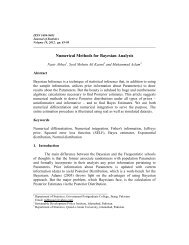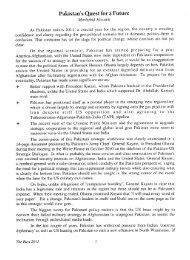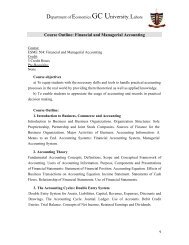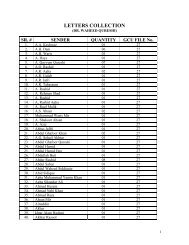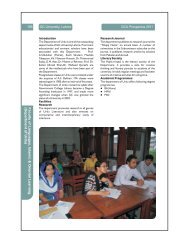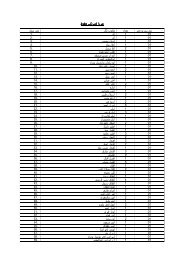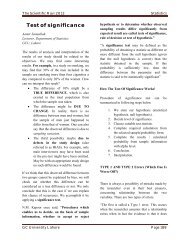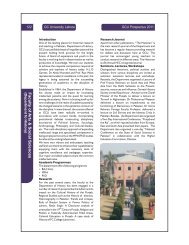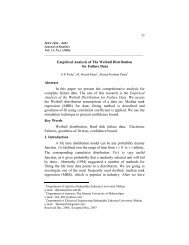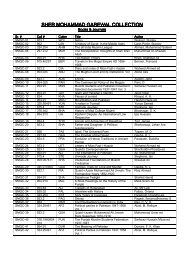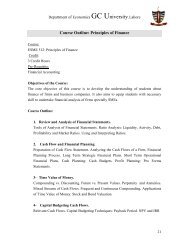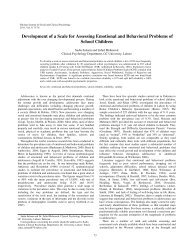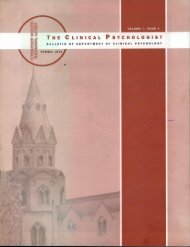Religiosity, Personal Meaning, and Psychological Well-being: A ...
Religiosity, Personal Meaning, and Psychological Well-being: A ...
Religiosity, Personal Meaning, and Psychological Well-being: A ...
You also want an ePaper? Increase the reach of your titles
YUMPU automatically turns print PDFs into web optimized ePapers that Google loves.
Pakistan Journal of Social <strong>and</strong> Clinical Psychology<br />
2012, Vol. 9, No. 2, 27-31<br />
<strong>Religiosity</strong>, <strong>Personal</strong> <strong>Meaning</strong>, <strong>and</strong> <strong>Psychological</strong> <strong>Well</strong>-<strong>being</strong>:<br />
A Study among Muslim Students in Engl<strong>and</strong><br />
Abdulaziz Aflakseir<br />
University of Shiraz, Iran<br />
Religion has been considered as a framework for the sense of meaning <strong>and</strong> purpose. The aim of the present<br />
study was to explore the perception of Muslim students who practice their religion towards meaning of life <strong>and</strong><br />
to investigate the association between religiosity, personal meaning, <strong>and</strong> psychological well-<strong>being</strong>. Respondents<br />
were 60 Muslim students studying at University of Southampton <strong>and</strong> Birmingham in Engl<strong>and</strong>. The participants<br />
were administered Life Attitude Profile-Revised Scale (Reker, 1999), Sources of <strong>Meaning</strong> Profile-Revised<br />
Scale (Reker, 1996), <strong>Psychological</strong> <strong>Well</strong>-Being Scale (Ryff, 1989), <strong>and</strong> Strength of Spiritual Belief Scale (King,<br />
Speck, & Thomas, 2001). Findings of this study showed that Muslim students perceived their life meaningful.<br />
They derived <strong>and</strong> experienced meaning from various sources <strong>and</strong> the most important sources of meaning were<br />
taking part in religious activities <strong>and</strong> engaging in personal relationships with family/friends <strong>and</strong> the least<br />
important sources of meaning were participation in hedonistic activities <strong>and</strong> acquiring material possession.<br />
Furthermore, there was a positive association between various dimensions of personal meaning <strong>and</strong> different<br />
components of psychological well-<strong>being</strong>, spirituality <strong>and</strong> religiosity. This study has implications for religious<br />
scholars <strong>and</strong> psychologists working on religion.<br />
Keywords: religiosity, personal meaning, psychological well-<strong>being</strong>, Muslim students<br />
Religion has been considered as a potential source of existential<br />
meaning that has a significant impact on psychological well-<strong>being</strong>.<br />
Religion may contribute directly to people’s well-<strong>being</strong> or indirectly<br />
by giving a sense of meaning <strong>and</strong> purposeful direction in life<br />
(Wong, 1989). A number of theorists believe that a sense of<br />
meaningfulness in life is essential to mental health (Frankl, 1976;<br />
Yalom, 1980). Contemporary research has shown that religiosity<br />
<strong>and</strong> existential meaning are important constructs in prevention of<br />
illness, promotion of wellness, <strong>and</strong> successful adaptation to life’s<br />
changing circumstances (Emmons, 2003; Pargament, Magyar, &<br />
Murray, 2005). <strong>Meaning</strong>lessness or existential vacuum, on the other<br />
h<strong>and</strong>, lies at the very root of psychopathology including neurosis,<br />
depression, suicidal behaviour, drug abuse, <strong>and</strong> alcohol dependence<br />
(Reker & Chamberlain, 2000).<br />
Religion is well suited to provide answers to some of the<br />
questions about life’s meaning. Baumeister (2005) postulated that<br />
part of the appeal of religion has been rooted in control <strong>and</strong> indeed,<br />
it is the control over life that offers. Similarly, Jung (1961) stated<br />
that “it is the role of religion to give meaning to life of a man” (p.<br />
89). There have been a number of studies examining the relationship<br />
between existential meaning in life <strong>and</strong> religiosity. Most of these<br />
studies indicate a positive relationship between them. For example,<br />
Yalom (1980) reported that a positive sense of meaning in life was<br />
associated with both self-transcendent values <strong>and</strong> deeply held<br />
religious beliefs.<br />
Research has demonstrated that meaning in life is a significant<br />
cognitive construct that affects mental well-<strong>being</strong> <strong>and</strong> helps in<br />
effective adaptation to difficulties in life. <strong>Personal</strong> meaning has been<br />
regarded as a protective factor in adaptation to life-threatening<br />
illness such as AIDS (Fife, 2005). <strong>Meaning</strong> in life has also been<br />
found to be positively correlated with higher self-esteem (Steger,<br />
2006), control (Krause & Shaw, 2004), life satisfaction (Steger &<br />
Kashdan, 2006), coping (Sherman & Simonton 2011), hope<br />
(Mascaro & Rosen, 2005), positive functioning (Diener & Seligman,<br />
2004), positive well-<strong>being</strong> (Scannell, Allen, & Burton, 2002), <strong>and</strong><br />
has been found to have a buffering effect against depression<br />
(Pinquart, 2002).<br />
Correspondence concerning this article should be addressed to Abdulaziz<br />
Aflakseir School of Psychology, University of Shiraz, Eram Campus Shiraz,<br />
Iran. Email: aaflakseir@shirazu.ac.ir<br />
There is an emphasis within Islamic literature on religious beliefs<br />
<strong>and</strong> practices <strong>being</strong> used as resources for dealing with life<br />
difficulties. Islamic teachings encourage people to be patient, to<br />
perform prayers, have trust in Allah, <strong>and</strong> turn to Allah for guidance<br />
<strong>and</strong> in times of need. Islamic beliefs also give individuals a<br />
meaningful interpretation of difficult events. The Quran clearly<br />
emphasizes that the difficulties in this world are to test the believers<br />
<strong>and</strong> also guides people to have patience in facing their problems.<br />
Several studies on religiosity <strong>and</strong> mental health among Muslim<br />
populations have been reported (Amer, Hovey, Fox, & Rezcallah,<br />
2008; Husain, 1998; Loewenthal Cinnirella, Evdoka, & Morphy,<br />
2001). In a qualitative study on elderly Malay Muslims, Mehta<br />
(1997) reported that elderly attributed their aging process <strong>and</strong> its<br />
accompanying decrements to the Will of Allah. Similarly, some<br />
respondents also mentioned reciting verses of the Holy Quran to<br />
overcome their headache. Hussain <strong>and</strong> Cochrane (2003) in a study<br />
on Muslim women with depression found that coping with their<br />
condition through religion was the most common strategy where<br />
they prayed for help <strong>and</strong> many offered prayers <strong>and</strong> read verses from<br />
the Holy Quran specifically to ask for protection from illness <strong>and</strong><br />
symptoms. Some of them also simply resumed the obligatory five<br />
daily prayers that they had either stopped performing or did not have<br />
a feeling indicating a sincere need for help. Loewenthal et al. (2001)<br />
conducted a study on depressed people among Christians, Jews,<br />
Muslims, Hindus, followers of other religions <strong>and</strong> non-religious<br />
people living in the UK <strong>and</strong> reported that Muslims believed more<br />
strongly than other faith groups in the efficacy of every form of<br />
religious activity in coping with depression. An overview of the<br />
related literature shows that most researches have been conducted<br />
on the relationship between religiosity, personal meaning, <strong>and</strong><br />
mental health among people who live in the West particularly in the<br />
North America. With regards to lack of research on Muslims<br />
perception of personal meaning, the present study tries to enhance<br />
our knowledge about the perception of life meaning in a group of<br />
Muslims.<br />
Objectives<br />
The aim of this research is to explore the perception towards life<br />
meaning of a group of practising Muslim students studying in<br />
Engl<strong>and</strong>. The study also explores the relationship between the sense<br />
of personal meaning, psychological well-<strong>being</strong>, spirituality, <strong>and</strong><br />
religiosity.<br />
27
AFLAKSEIR 28<br />
Hypothesis<br />
It was hypothesized that a positive relationship would exist<br />
among personal meaning, psychological well-<strong>being</strong>, spirituality, <strong>and</strong><br />
religiosity in practising Muslim students of Engl<strong>and</strong>.<br />
Participants<br />
Method<br />
Sixty Muslim students (39 men <strong>and</strong> 21 women) were recruited<br />
from the Prayer Room at the Universities of Southampton <strong>and</strong><br />
Birmingham in the UK. Majority of the students had come from<br />
Islamic countries <strong>and</strong> were studying at the university. Their age<br />
ranged from 18 to 28 years with an average age of 22 years. Most<br />
participants were undergraduates.<br />
Measures<br />
1. Life Attitude Profile-Revised (LAP-R; Reker, 1999). This scale is<br />
intended to assess both the degree of meaning <strong>and</strong> purpose <strong>and</strong> the<br />
strength of motivation to find meaning <strong>and</strong> purpose in life. The<br />
LAP-R comprises 48 items, each subscale has 8 items <strong>and</strong> each item<br />
is rated on a 7-point Likert scale of agreement, ranging from 1<br />
(strongly disagree) to 7 (strongly agree). Sub-scale scores range<br />
from 8 to 56. The scale consists of six sub-scales including Purpose<br />
(PU), Coherence (CO), Choice/Responsibility (C/R), Death<br />
Acceptance (DA), Existential Vacuum (EV), <strong>and</strong> Goal Seeking<br />
(GS). It also has two composite scales including <strong>Personal</strong> <strong>Meaning</strong><br />
Index (PMI) <strong>and</strong> Existential Transcendence (ET). Reker (1999) has<br />
reported a Cronbach alpha ranging from 0.77 to 0.91 for different<br />
subscales. In addition, test-retest reliability has been reported to<br />
range from 0.77 to 0.90 for different subscales. The scale also have<br />
good concurrent validity with other valid personal meaning scales<br />
such as Purpose in Life (Crumbaugh & Maholick, 1964) ranging<br />
from .24 to .75.<br />
2. Sources of <strong>Meaning</strong> Profile-Revised scale (SOMP-R; Reker,<br />
1996). This scale is designed to measure sources of meaning in life.<br />
This scale focuses on the various sources of meaning that<br />
individuals derive from their daily lives. It comprises 16 items <strong>and</strong><br />
each source is rated on a 7-point Likert scale ranging from 1 (not at<br />
all meaningful) to 7 (extremely meaningful). The scores of the scale<br />
range from 16 to 112 with a higher total score indicating that the<br />
person has a variety of meaningful sources in his/her life. The scale<br />
is divided into four meaning orientations (levels) including Self-<br />
Transcendence, Collectivism, Self-Preoccupation, <strong>and</strong><br />
Individualism. Each subscale contains four items <strong>and</strong> their scores<br />
range from 4 to 28. The results of psychometric testing have shown<br />
an internal consistency ranging from .71 to .80 <strong>and</strong> test-retest<br />
reliability coefficient of .70 in Canada <strong>and</strong> Australia. The concurrent<br />
validity of the scale has been reported to be .34 (Prager, 1996;<br />
Reker, 1996).<br />
3. The <strong>Psychological</strong> <strong>Well</strong>-Being Scale (Ryff, 1989). This scale is<br />
used to assess the positive level of psychological well-<strong>being</strong>. A<br />
recent conceptualization of psychological well-<strong>being</strong> is the multidimensional<br />
model proposed by Ryff <strong>and</strong> Singer (1998). This scale<br />
includes six dimensions: Self-acceptance, Positive Relations with<br />
Others, Autonomy, Environmental Mastery, Purpose in Life, <strong>and</strong><br />
<strong>Personal</strong> Growth <strong>and</strong> has three different versions. For this study, 54-<br />
item scale was used <strong>and</strong> responses were made on a 6-point Likert<br />
scale ranging from 1 (very strongly disagree) to 6 (very strongly<br />
agree). Possible scores for each subscale ranges from 9 to 54. A high<br />
internal consistency ranging from .86 to .93 is reported for different<br />
dimensions of the scale (Ryff, 1989). Many studies have used this<br />
scale <strong>and</strong> have reported a good validity (Kafka & Kozma, 2002; Van<br />
Dierendonck, 2004).<br />
4. Strength of Spiritual Belief Scale (King et al., 2001). This scale<br />
measures the degree to which a person holds strong spiritual beliefs.<br />
It is composed of 6 items on a 10-point Likert scale <strong>and</strong> scores range<br />
from 0 to 60. High scores in this measure indicate that a person<br />
holds strongly to his beliefs <strong>and</strong> these beliefs play a crucial role in<br />
his lives. The authors claim that this scale has been designed<br />
specifically to assess a wide range of spiritual beliefs not specific to<br />
any religion. King et al has reported Cronbach alpha of .89 <strong>and</strong><br />
validity of .66 for this scale. In Iranian sample Cronbach alpha has<br />
been reported to be .84 <strong>and</strong> concurrent validity to be .76 (Aflakseir,<br />
2007). A single-item scale was also used to assess the religiosity of<br />
the sample. The participant responded to item, "How important is<br />
religion in your daily life" <strong>and</strong> the answers ranged from 1 (nothing)<br />
to 6 (very important).<br />
Procedure<br />
The questionnaires were distributed at the prayer room of the<br />
Universities <strong>and</strong> Muslim students were asked to complete the<br />
consent form <strong>and</strong> research measures. They were asked to send them<br />
back by post to the researchers using pre-paid envelopes. Nearly all<br />
students returned their completed questionnaires, but a few were<br />
excluded from the study because of missing data.<br />
Descriptive Findings<br />
Results<br />
Mean <strong>and</strong> st<strong>and</strong>ard deviation on the six dimensions <strong>and</strong> two<br />
composite scales of LAP-R are presented in Table 1. Participants<br />
scored highest on Coherence (M = 45.07, SD = 6.57) followed by<br />
Goal Seeking (M = 42.0, SD = 6.75) <strong>and</strong> Purpose (M = 41.01, SD =<br />
6.35) as they are near the upper limit of the scale, i.e., 56 <strong>and</strong> the<br />
lowest on Existential Vacuum (M = 27.08, SD = 9.54) followed by<br />
Death Acceptance (M = 30.17, SD = 8.61) <strong>and</strong><br />
Choice/Responsibility (M = 37.03, SD = 7.35).<br />
Table 2 presents mean <strong>and</strong> st<strong>and</strong>ard deviation of SOMP-R items.<br />
Taking part in religious activities (M = 6.45, SD = 0.97) <strong>and</strong><br />
engaging in personal relationships with family/friends (M = 6.42,<br />
SD = 0.79) were ranked as the most important sources of personal<br />
meaning as their scores are near 7 which was the highest point in 7-<br />
point Likert scale. The least important sources of personal meaning<br />
were participation in hedonistic activities (M = 1.63, SD = 1.27) <strong>and</strong><br />
acquiring material possession in order to enjoy good life (M = 3.00,<br />
SD = 1.63). In case of different levels of personal goals or meaning<br />
orientation the results indicated students to score highest on Selftranscendent<br />
(M = 24.84, SD = 2.28) <strong>and</strong> lowest on Selfpreoccupation<br />
(M = 15.64, SD = 2.88) (Table 3).<br />
The results of different subscales of <strong>Psychological</strong> <strong>Well</strong>-<strong>being</strong><br />
Scale are presented in Table 4.The highest score is on <strong>Personal</strong> Gro-<br />
Table 1<br />
Mean <strong>and</strong> St<strong>and</strong>ard Deviation of the Life Attitude Profile-Revised<br />
(N = 60)<br />
Dimensions M SD<br />
Purpose 41.01 6.35<br />
Coherence 45.07 6.57<br />
Choice/Responsibility 37.05 7.35<br />
Death Acceptance 30.17 8.61<br />
Existential Vacuum 27.08 9.54<br />
Goal Seeking 42.00 6.75<br />
<strong>Personal</strong> <strong>Meaning</strong> Index 86.57 10.96<br />
Existential Transcendence 86.25 23.11
RELIGIOSITY, PERSONAL MEANING AND PSYCHOLOGICAL WELL-BEING 29<br />
Table 2<br />
Mean <strong>and</strong> St<strong>and</strong>ard Deviation of Sources of <strong>Meaning</strong> Profile-<br />
Revised Items (N = 60)<br />
Items M SD<br />
Taking part in religious activities 6.45 0.97<br />
Engaging in personal relationships with<br />
6.42 0.79<br />
family/friends<br />
Being of service to others 6.03 1.10<br />
Preserving human values <strong>and</strong> ideals 5.93 0.96<br />
Experiencing personal growth 5.93 1.08<br />
Meeting basic, everyday needs 5.66 1.10<br />
Interest in human rights (humanistic concerns) 5.57 1.03<br />
Feeling financially secure 5.39 1.27<br />
Interest in social causes 5.36 1.38<br />
Leaving a legacy for the next generation 5.27 1.28<br />
Taking part in creative needs 5.03 1.38<br />
Preservation of culture <strong>and</strong> tradition 5.03 1.59<br />
Being acknowledged for personal achievements 4.84 1.27<br />
Participation in leisure activities 4.57 1.63<br />
Acquiring material possession in order to enjoy the 3.00 1.63<br />
good life<br />
Participation in “hedonistic” activities 1.63 1.27<br />
Table 3<br />
Mean <strong>and</strong> St<strong>and</strong>ard Deviation of Different Levels of <strong>Personal</strong> Goals<br />
(N = 60)<br />
Levels of <strong>Personal</strong> <strong>Meaning</strong> M SD<br />
Self-transcendence 24.84 2.28<br />
Collectivism 21.16 3.62<br />
Individualism 20.52 3.48<br />
Self-preoccupation 15.64 2.88<br />
Table 4<br />
Mean <strong>and</strong> St<strong>and</strong>ard Deviation of <strong>Psychological</strong> <strong>Well</strong>-Being Scale (N<br />
= 60)<br />
Subscales M SD<br />
Positive Relation with Others 42.21 8.25<br />
Autonomy 38.21 6.53<br />
Environmental Mastery 37.45 5.93<br />
<strong>Personal</strong> Growth 43.21 5.67<br />
Self Acceptance 41.30 6.03<br />
wth (M = 43.21, SD = 5.67) followed by Positive Relation with<br />
Others (M = 42.21, SD = 8.25), Self-acceptance (M = 41.30, SD =<br />
6.03), Autonomy (M = 38.21, SD = 6.53), <strong>and</strong> Environmental<br />
Mastery (M = 37.45, SD = 5.93). Participants mean on Strength of<br />
Spiritual Belief Scale was 54.6 (SD = 6.50) which is a high score as<br />
it is near the upper limit of the scale, i.e., 69 <strong>and</strong> their mean on the<br />
single-item scale (the importance of religion) was also high (M =<br />
5.7, SD = .76).<br />
Relationship between <strong>Personal</strong> <strong>Meaning</strong>, <strong>Psychological</strong> <strong>Well</strong>-<strong>being</strong>,<br />
Spirituality, <strong>and</strong> religiosity<br />
Pearson product-moment correlation between subscales of Life<br />
Attitude Profile-Revised, <strong>Psychological</strong> <strong>Well</strong>-<strong>being</strong>, <strong>and</strong> Spirituality<br />
<strong>and</strong> <strong>Religiosity</strong> is given in Table 5. The results indicate significant<br />
positive correlation of Purpose with Environmental Mastery (r =<br />
.38, p < .05), Positive Relation with Others (r = .42, p < .001), Selfacceptance<br />
(r = .40, p < .05), <strong>Personal</strong> Growth (r = .40, p < .05),<br />
Spirituality (r = .32, p < .05), <strong>and</strong> <strong>Religiosity</strong> (r = .35, p < .05).<br />
Coherence is significantly positively correlated with Environmental<br />
Mastery (r = .39, p < .05), Positive Relation with Others (r = .68, p<br />
< .001), <strong>Personal</strong> Growth (r = .34, p < .05), Spirituality (r = .40, p <<br />
.05) <strong>and</strong> <strong>Religiosity</strong> (r = .42, p < .05). Choice/Responsibility only<br />
has significant positive correlation with <strong>Personal</strong> Growth (r = .35, p<br />
< .05). Existential Vacuum is significantly negatively correlated<br />
with all subscales of psychological well-<strong>being</strong> ranging from -.42 to -<br />
.63. Goal seeking has significant negative correlation only with Selfacceptance<br />
(r = -.45, p < .001). <strong>Personal</strong> meaning index is<br />
significantly positively correlated with Environmental Mastery (r =<br />
.43, p < .001), Positive Relation with Others (r = .55, p < .001),<br />
Self-acceptance (r = .34, p < .05), <strong>Personal</strong> Growth (r = .42, p <<br />
.001), Spirituality (r = .35, p < .05), <strong>and</strong> <strong>Religiosity</strong> (r = .37, p <<br />
.05). Existential Transcendence has significant positive correlation<br />
with all subscales of psychological well-<strong>being</strong> <strong>and</strong> spirituality <strong>and</strong><br />
religiosity ranging from .45 to .66. Death acceptance has no<br />
significant relation with subscales of psychological well-<strong>being</strong>,<br />
spirituality <strong>and</strong> religiosity.<br />
Discussion<br />
The purpose of the study was to explore the sense of life meaning<br />
among Muslim students living <strong>and</strong> studying in Engl<strong>and</strong> <strong>and</strong> to see<br />
the relationship between personal meaning, psychological well<strong>being</strong>,<br />
spirituality, <strong>and</strong> religiosity. The results of this study<br />
demonstrated that Muslim students who practiced their religion<br />
perceived their life meaningful. An interesting finding of this study<br />
was that Muslim students scored higher on Coherence component<br />
than Purpose dimension in the LAP-R. The items of this dimension<br />
(Coherence), e.g., “I have a clear underst<strong>and</strong>ing of the ultimate<br />
meaning of life” seems to be more related to existential meaning<br />
while the Purpose dimension, e.g., “in my life I have very clear<br />
goals <strong>and</strong> aims” is more related to situational meaning. Therefore,<br />
Muslim students seem to perceive their existential meaning. With<br />
regard to Death Acceptance respondents obtained lower scores. The<br />
reason for it is that some items of this subscale are in conflict with<br />
Table 5<br />
Correlation between Subscales of Life Attitude Profile-Revised, <strong>Psychological</strong> <strong>Well</strong>-Being Scale, Spirituality <strong>and</strong> <strong>Religiosity</strong> (N = 60)<br />
Environmental<br />
Positive Self <strong>Personal</strong><br />
Autonomy<br />
Mastery<br />
Relation acceptance Growth<br />
Spirituality <strong>Religiosity</strong><br />
Purpose .38* .13 .42** .40* .40* .32* .35*<br />
Coherence .39* .26 .68** .20 .34* .40* .42**<br />
Choice/Responsibility .29 .03 .29 .18 .35* .06 .09<br />
Death Acceptance .01 -.03 -.09 -.14 -.21 -.06 -.08<br />
Existential vacuum -.42** -.62** -.54** -.63** -.42** -.45** -.48**<br />
Goal seeking -.15 -.11 -.16 -.45** .07 .13 .10<br />
<strong>Personal</strong> <strong>Meaning</strong> .43** .18 .55** .34* .42** .35* .37*<br />
Existential Transcendence .54** .50** .66** .59** .53** .47** .45**<br />
*p < .05. **p < .001.
AFLAKSEIR 30<br />
Islamic teachings therefore, participants’ scores on these items were<br />
lowest in the scale, e.g., death makes little difference to me one way<br />
or another, the thought of death seldom enters my mind. Islamic<br />
principles teach followers to think about death to avoid materialism<br />
<strong>and</strong> indifference towards death (Motahari, 1994). Therefore, low<br />
score on these items does not essentially mean they do not accept<br />
death as respondents mean on some of the items in Death<br />
Acceptance subscale was high. The lower score of students on<br />
Choice/Responsibility dimension may be also because some of its<br />
items do not correspond with Islamic teachings, e.g., “I know where<br />
my life is going in the future”, “my life is in my h<strong>and</strong>s <strong>and</strong> I am in<br />
control of it”, “I determine what happens in my life”. According to<br />
Islamic teachings, life is in Allah’s h<strong>and</strong> <strong>and</strong> Allah determines our<br />
life.<br />
With regard to the sources of personal meaning, the results were<br />
significantly different from the previous studies (Prager, 2001).<br />
Muslim students perceived Self-transcendence sources (sources that<br />
transcend the self <strong>and</strong> go beyond ego to encompass cosmic or<br />
ultimate meaning) to be more important than other sources of<br />
meaning such as Self-preoccupation. These results reflect that<br />
religious teachings may have a significant impact on the perception<br />
of Muslim students as there is an emphasis within Islamic literature<br />
on transcending sources of meaning. For example, many verses of<br />
Quran mention remembrance <strong>and</strong> patience. A research has shown<br />
that Muslim students practicing their religion have more personal<br />
meaning than Iranian students in UK (Aflakseir, 2007).<br />
The results of the present study showed significant association<br />
between some dimensions of personal meaning, psychological well<strong>being</strong>,<br />
spirituality, <strong>and</strong> religiosity. Therefore, the results support the<br />
research hypothesis. It was found that the dimensions Purpose,<br />
Coherence, Existential Vacuum, <strong>Personal</strong> <strong>Meaning</strong> Index, <strong>and</strong><br />
Existential Transcendence of personal meaning were significantly<br />
associated with most components of psychological well-<strong>being</strong><br />
(Environmental Mastery, Positive Relations, Self-acceptance, <strong>and</strong><br />
<strong>Personal</strong> Growth) suggesting that if a person perceives his or her life<br />
to be meaningful then he or she would feel more psychologically<br />
well as compared to those who do not perceive their life meaningful<br />
which is consistent with previous researches (Diener & Seligman,<br />
2004; Scannell et al., 2002; Steger & Kashdan, 2006). The reason<br />
that above mentioned dimensions of LAP-R are associated with<br />
most of the components of <strong>Psychological</strong> <strong>Well</strong>-<strong>being</strong> Scale may be<br />
that these dimensions are more interrelated constructs <strong>and</strong> they are<br />
considered as a part of the concept of meaning in most theories <strong>and</strong><br />
they are also measured which assessing personal meaning, while the<br />
dimensions of Choice/Responsibility, Death Acceptance, <strong>and</strong> Goal<br />
Seeking seem to be less related to the concept of meaning<br />
(Antonovsky, 1994; Reker, 1999). Regarding the relation between<br />
some dimensions of personal meaning (Purpose, Coherence,<br />
Existential Vacuum, <strong>Personal</strong> <strong>Meaning</strong> Index, <strong>and</strong> Existential<br />
Transcendence), spirituality <strong>and</strong> religiosity, this study showed a<br />
significant positive association between them <strong>and</strong> Existential<br />
Vacuum had negative association with spirituality <strong>and</strong> religiosity.<br />
Previous researches have also indicated a positive relationship<br />
between personal meaning, spirituality <strong>and</strong> religiosity (Baumeister,<br />
2005; Zika & Chamberlain, 1992). The current study indicated that<br />
religion enhances meaning of life by providing unifying philosophy<br />
of life <strong>and</strong> serves as an integrating <strong>and</strong> stabilizing force that<br />
provides a framework for interpreting life’s challenges <strong>and</strong> provides<br />
a resolution to difficult conditions. Furthermore, religion enhances<br />
meaning by offering more direct opportunities for control over life.<br />
The believer who is able to accept otherwise inexplicable events as<br />
<strong>being</strong>, “God’s willing” may be satisfied with this form of<br />
interpretive control. Having a sense of meaning has an important<br />
impact on physical <strong>and</strong> psychological well-<strong>being</strong> as a coping<br />
mechanism particularly when individuals suffer <strong>and</strong> face<br />
challenging life events. Furthermore, meaning in life is a significant<br />
cognitive construct <strong>and</strong> affects mental well-<strong>being</strong> <strong>and</strong> helps in<br />
effective adaptation to difficulties in life. The results of this study<br />
support previous research indicating a positive association between<br />
religiosity, personal meaning <strong>and</strong> mental health (Emmon, 2002).<br />
The findings of this study reflect the issue that Islamic teachings<br />
play an effective role in promotion of self-growth, self-acceptance,<br />
<strong>and</strong> other positive psychological well-<strong>being</strong> <strong>and</strong> that Muslims<br />
mainly drive personal meaning through religion <strong>and</strong> that Islamic<br />
belief system may provide a philosophical framework for followers<br />
to perceive the world <strong>and</strong> their life meaningful. Such research could<br />
provide a foundation for development of interventions based on<br />
religious beliefs targeted for individuals facing mental health<br />
problems.<br />
Limitations <strong>and</strong> Suggestions<br />
There were several limitations in the current study. First one is<br />
concerned with the sample size of the study. A limited sample of 60<br />
students is not sufficient for any generalization on Muslims.<br />
Furthermore, the sample was drawn from two universities, while it<br />
would be more acceptable <strong>and</strong> representative if the samples are<br />
recruited from numerous universities with students of diverse<br />
backgrounds. Future studies may consider comparing religiosity <strong>and</strong><br />
sense of personal meaning between Muslims living in Western <strong>and</strong><br />
in Islamic countries <strong>and</strong> gender can also be taken into account.<br />
Conclusion<br />
The present study examined personal meaning among a group of<br />
Muslim students studying at the universities of UK. This<br />
preliminary study indicated that Muslim students practicing their<br />
religion had high sense of existential meaning. The participants also<br />
perceived self-transcendence sources of meaning as more important<br />
than other sources of meaning, e.g., self-preoccupation). This study<br />
also highlighted that participants with higher level of personal<br />
meaning had higher scores on different dimensions of psychological<br />
well-<strong>being</strong> such as Self-acceptance, Positive Relation with Others,<br />
<strong>Personal</strong> Growth, <strong>and</strong> Environmental Mastery. Furthermore, the<br />
results indicated that spirituality <strong>and</strong> religious beliefs were important<br />
components in constructing life meaning among this group.<br />
References<br />
Aflakseir, A. (2007). The influence of religious coping <strong>and</strong> personal<br />
meaning on the mental health of disabled Iranian war veterans<br />
(Unpublished PhD thesis). University of Southampton, United<br />
Kingdom.<br />
Amer, M., Hovey, J. D., Fox, C. M., & Rezcallah, A. (2008). Initial<br />
development of the Brief Arab Religious Coping Scale<br />
(BARCS). Journal of Muslim Mental Health, 3, 69-88.<br />
Antonovsky, A. (1994). The structure <strong>and</strong> properties of the sense of<br />
coherence scale. In M. McCubbin (Ed.), Sense of coherence <strong>and</strong><br />
resiliency: Stress, coping, <strong>and</strong> health (pp. 55-78). Madison, WI:<br />
University of Wisconsin-Madison.<br />
Baumeister, R. F. (2005). The cultural animal: Human nature,<br />
meaning <strong>and</strong> social life. New York: Oxford University Press.<br />
Crumbaugh, J. C., & Maholick, L. T. (1964). An experimental study<br />
in existentialism: The psychometric approach to Frankl’s<br />
concept of noogenic neurosis. Journal of Clinical Psychology,<br />
20, 200-207.<br />
Diener, E., & Seligman, M. E. P. (2004). Beyond money: Toward an<br />
economy of well-<strong>being</strong>. <strong>Psychological</strong> Science in the Public<br />
Interest, 5, 1-31.<br />
Emmons, R. A. (2003). The psychology of ultimate concerns:<br />
Motivation <strong>and</strong> spirituality in personality. London: Guilford
RELIGIOSITY, PERSONAL MEANING AND PSYCHOLOGICAL WELL-BEING 31<br />
Press.<br />
Fife, B. L. (2005). The role of constructed meaning in adaptation to<br />
the onset of life-threatening illness. Social Science <strong>and</strong><br />
Medicine, 61, 2132-2143.<br />
Frankl, V. E. (1976). Man’s search for meaning. New York:<br />
Washington Square Press.<br />
Husain, S. A. (1998). Religion <strong>and</strong> mental health from the Muslim<br />
perspective. In H. G. Koenig (Ed.), H<strong>and</strong>book of religion <strong>and</strong><br />
mental health (pp. 279-290). New York: Academic Press.<br />
Hussain, F., & Cochrane, R. (2003). Living with depression: Coping<br />
strategies used by South Asian women living in the UK<br />
suffering from depression. Mental Health, Religion <strong>and</strong> Culture,<br />
6, 21-44.<br />
Jung, C. G. (1961). Memories, dreams, reflections. New York:<br />
Pantheon.<br />
Kafka, G. J., & Kozma, A. (2002). The construct validity of Ryff's<br />
Scales of <strong>Psychological</strong> <strong>Well</strong>-<strong>being</strong> (SPWB) <strong>and</strong> their<br />
relationship to measures of subjective well-<strong>being</strong>. Social<br />
Indicators Research, 57, 171-190.<br />
King, M., Speck, P., & Thomas, A. (2001). The Royal Free<br />
Interview for Spiritual <strong>and</strong> Religious Beliefs: Development <strong>and</strong><br />
validation of a self-report version. <strong>Psychological</strong> Medicine, 31,<br />
1015-1023.<br />
Krause, N., & Shaw, B. A. (2004). Role-specific control, personal<br />
meaning <strong>and</strong> health in late life. Research on Aging, 25, 556-586.<br />
Loewenthal, K. M., Cinnirella, M., Evdoka, G., & Morphy, P.<br />
(2001). Faith conquers all? Beliefs about the role of religious<br />
factors in coping with depression among different cultural<br />
religious groups in the UK. British Journal of Medical<br />
Psychology, 74, 293-303.<br />
Mascaro, N., & Rosen, D. H. (2005). Existential meaning's role in<br />
the enhancement of hope <strong>and</strong> prevention of depressive<br />
symptoms. Journal of <strong>Personal</strong>ity, 73, 985-1014.<br />
Mehta, K. K. (1997). The impact of religious beliefs <strong>and</strong> practice on<br />
aging: A cross-cultural comparison. Journal of Aging Studies,<br />
11, 101-114.<br />
Motahari, M. (1994). Eternal life. Tehran: Sadra Publishing.<br />
Pargament, K. I., Magyar, G., & Murray, N. (2005). The sacred <strong>and</strong><br />
the search for significance: Religion as a unique process.<br />
Journal of Social Issues, 61, 665-687.<br />
Pinquart, M. (2002). Creating <strong>and</strong> maintaining purpose in life in old<br />
age: A meta-analysis. Ageing International, 27, 90-104.<br />
Prager, E. (1996). Exploring personal meaning in an age<br />
differentiated Australian sample: Another look at the sources of<br />
meaning profile (SOMP). Journal of Aging Studies, 10, 117-136.<br />
Prager, E. (2001). Sources of meaning in life for young <strong>and</strong> old<br />
Israeli Jews <strong>and</strong> Arabs. Journal of Aging Studies, 15, 253-269.<br />
Reker, G. T. (1996). Manual of the Sources of <strong>Meaning</strong> Profile-<br />
Revised (SOMP-R). Peterborough, ON: Student Psychologists<br />
Press.<br />
Reker, G. T. (1999). Manual of Life Attitude Profile–Revised.<br />
Peterborough, ON: Students Psychologists Press.<br />
Reker, G. T., & Chamberlain, K. (2000). Exploring existential<br />
meaning: Optimizing human development across the life span.<br />
CA: Sage.<br />
Ryff, C. D. (1989). Happiness is everything, or is it? Explorations<br />
on the meaning of psychological well-<strong>being</strong>. Journal of<br />
<strong>Personal</strong>ity <strong>and</strong> Social Psychology, 57, 1069-1081.<br />
Ryff, C. D., & Singer, B. H. (1998). <strong>Psychological</strong> well-<strong>being</strong>:<br />
<strong>Meaning</strong>, measurement, <strong>and</strong> implications for psychotherapy<br />
research. Psychotherapy <strong>and</strong> Psychosomatics, 65, 14-23<br />
Scannell, E. D., Allen, F. C. L., & Burton, J. (2002). <strong>Meaning</strong> in life<br />
<strong>and</strong> positive <strong>and</strong> negative well-<strong>being</strong>. North American Journal<br />
of Psychology, 4, 93-112.<br />
Sherman, A. C., & Simonton, S. (2011). Effects of personal<br />
meaning among patients in primary <strong>and</strong> specialized care:<br />
Associations with psychosocial <strong>and</strong> physical outcomes.<br />
<strong>Psychological</strong> Health, 4, 1-16.<br />
Steger, M. F. (2006). An illustration of issues in factor extraction<br />
<strong>and</strong> identification of dimensionality in psychological assessment<br />
data. Journal of <strong>Personal</strong>ity Assessment, 86, 263-272.<br />
Steger, M. F., & Kashdan, T. B. (2006). Stability <strong>and</strong> specificity of<br />
meaning in life <strong>and</strong> life satisfaction over one year: Implications<br />
for outcome assessment. Journal of Happiness Studies, 8, 161-<br />
179.<br />
Van Dierendonck, D. (2004). The construct validity of Ryff's Scales<br />
of <strong>Psychological</strong> <strong>Well</strong>-<strong>being</strong> <strong>and</strong> its extension with spiritual<br />
well-<strong>being</strong>. <strong>Personal</strong>ity <strong>and</strong> Individual Differences, 36, 629-643.<br />
Wong, T. P. (1989). <strong>Personal</strong> meaning <strong>and</strong> successful aging.<br />
Canadian Psychology, 30(3), 516-525.<br />
Yalom, I. D. (1980). Existential psychotherapy. New York: Basic<br />
Books.<br />
Zika, S., & Chamberlain, K. (1992). On the relation between<br />
meaning in life <strong>and</strong> psychological well-<strong>being</strong>. British Journal of<br />
Psychology, 83, 133-145.<br />
Received December 20, 2011<br />
Revision Received March 6, 2012<br />
Accepted March 12, 2012



